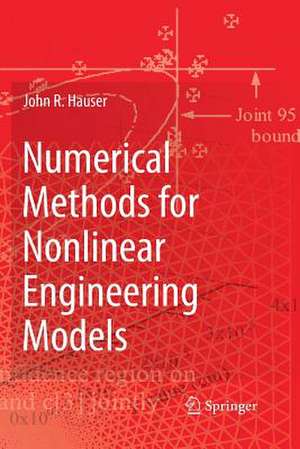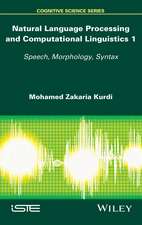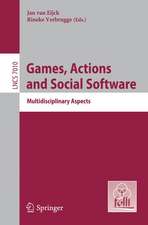Numerical Methods for Nonlinear Engineering Models
Autor John R. Hauseren Limba Engleză Paperback – 30 apr 2017
| Toate formatele și edițiile | Preț | Express |
|---|---|---|
| Paperback (1) | 1649.10 lei 43-57 zile | |
| SPRINGER NETHERLANDS – 30 apr 2017 | 1649.10 lei 43-57 zile | |
| Mixed media product (1) | 1666.41 lei 43-57 zile | |
| SPRINGER NETHERLANDS – 26 mar 2009 | 1666.41 lei 43-57 zile |
Preț: 1649.10 lei
Preț vechi: 2061.37 lei
-20% Nou
Puncte Express: 2474
Preț estimativ în valută:
315.65€ • 342.99$ • 265.32£
315.65€ • 342.99$ • 265.32£
Carte tipărită la comandă
Livrare economică 21 aprilie-05 mai
Preluare comenzi: 021 569.72.76
Specificații
ISBN-13: 9789401777070
ISBN-10: 9401777071
Pagini: 1013
Ilustrații: XIII, 1013 p.
Dimensiuni: 155 x 235 x 51 mm
Greutate: 1.41 kg
Ediția:Softcover reprint of the original 1st ed. 2009
Editura: SPRINGER NETHERLANDS
Colecția Springer
Locul publicării:Dordrecht, Netherlands
ISBN-10: 9401777071
Pagini: 1013
Ilustrații: XIII, 1013 p.
Dimensiuni: 155 x 235 x 51 mm
Greutate: 1.41 kg
Ediția:Softcover reprint of the original 1st ed. 2009
Editura: SPRINGER NETHERLANDS
Colecția Springer
Locul publicării:Dordrecht, Netherlands
Cuprins
to Nonlinear Engineering Problems and Models.- Numerical Fundamentals and Computer Programming.- Roots of Nonlinear Equations.- Solving Sets of Equations: Linear and Nonlinear.- Numerical Derivatives and Numerical Integration.- Interpolation.- Curve Fitting and Data Plotting.- Statistical Methods and Basic Statistical Functions.- Data Models and Parameter Estimation.- Differential Equations: Initial Value Problems.- Differential Equations: Boundary Value Problems.- Partial Differential Equations: Finite Difference Approaches.- Partial Differential Equations: The Finite Element Method.
Recenzii
From the reviews:
“This voluminous book by Hauser … covers numerical topics ranging from roots of nonlinear equations to introductory finite element method. The advantage of this work lies in the author’s approach of show-and-tell or ‘learning by example.’ … The examples are almost exclusively in the area of nonlinear electronics … which may be quite advantageous for electronics engineers. … Summing Up: Recommended. Upper-division undergraduate through professional collections.” (R. N. Laoulache, Choice, Vol. 47 (3), November, 2009)
“The book represents a comprehensive guide for the exploitation of standard numerical tools in nonlinear engineering problems. The presentation style ensures a balanced construction in providing mathematical knowledge illustrated by relevant examples. … suitable for self-study and teaching support at the first postgraduate level. The book is recommended to educators interested in preparing or upgrading lecture notes and seminars, students specializing in different fields of engineering, and practitioners working with various types of nonlinear models.” (Octavian Pastravanu, Zentralblatt MATH, Vol. 1173, 2009)
“This voluminous book by Hauser … covers numerical topics ranging from roots of nonlinear equations to introductory finite element method. The advantage of this work lies in the author’s approach of show-and-tell or ‘learning by example.’ … The examples are almost exclusively in the area of nonlinear electronics … which may be quite advantageous for electronics engineers. … Summing Up: Recommended. Upper-division undergraduate through professional collections.” (R. N. Laoulache, Choice, Vol. 47 (3), November, 2009)
“The book represents a comprehensive guide for the exploitation of standard numerical tools in nonlinear engineering problems. The presentation style ensures a balanced construction in providing mathematical knowledge illustrated by relevant examples. … suitable for self-study and teaching support at the first postgraduate level. The book is recommended to educators interested in preparing or upgrading lecture notes and seminars, students specializing in different fields of engineering, and practitioners working with various types of nonlinear models.” (Octavian Pastravanu, Zentralblatt MATH, Vol. 1173, 2009)
Textul de pe ultima copertă
The purpose of this book is to develop and illustrate various numerical computer based methods that can be used for engineering models and equations. The intended audience is the practicing engineer who needs to model real world engineering models or the upper level engineering undergraduate or first year graduate student interested in developing skills in computer models of engineering problems. The material is presented in a "learning by example" style whereby many examples are used to develop and illustrate concepts as opposed to extensive mathematical treatments. The book presents an integrated approach to engineering models whereby linear models are treated as simple special cases of more general approaches appropriate for nonlinear models. In addition to standard topics in numerical methods, the material covers the estimation of parameters associated with engineering models and the statistical nature of modeling with nonlinear models. Topics covered include coupled systems of nonlinear equations and coupled systems of nonlinear differential equations.
For all the topics covered extensive computer code is developed in a modern computer language that is easy to program and understand. The developed code can be readily used to model real world engineering problems. Finally for all topic areas extensive discussion is included of the accuracy that can be achieved with the various numerical methods and methods are developed that can be used to access the accuracy of the modeling methods.
The book assumes only the normal mathematical background of the introductory college level mathematics courses through calculus. In addition the material can be readily understood by anyone familiar with at least one computer programming language.
For all the topics covered extensive computer code is developed in a modern computer language that is easy to program and understand. The developed code can be readily used to model real world engineering problems. Finally for all topic areas extensive discussion is included of the accuracy that can be achieved with the various numerical methods and methods are developed that can be used to access the accuracy of the modeling methods.
The book assumes only the normal mathematical background of the introductory college level mathematics courses through calculus. In addition the material can be readily understood by anyone familiar with at least one computer programming language.
Caracteristici
The emphasis is on nonlinear engineering models and equations as opposed to linear models Linear models and equations are treated conveniently as just special cases of more general nonlinear models For each chapter and topic area covered, the theory is discussed and computer code is developed and presented such that the reader can conveniently apply the developed code to practical engineering problems For each topic covered at least one approach is extensively developed leading to working computer code that can be applied to nonlinear problems The computer code is developed in a modern scripting language that is very easy to program and understand by the reader

















